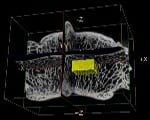“Antimatter” is one of the big stars in the new Ron Howard film “Angels & Demons.” After seeing the movie, people may wonder how much of the science in the film is actually real.
SMU Physics Professor Fredrick Olness says the new action thriller exploits cutting-edge science to create an exciting tale of science fiction mystery and imagination. “Angels & Demons” takes key ideas that are based upon scientific fact, Olness comments, and then exaggerates the details for the purpose of storytelling — and that’s the transformation from “science” to “science fiction.”
In the movie, which opened May 15, members of a centuries-old secret society steal a small container of antimatter from the CERN particle physics laboratory in Europe and threaten to blow up the Vatican. Tom Hanks, as a Harvard professor, tries to stop the society.
“Angels & Demons” is billed as the prequel to the 2006 box-office hit “The Da Vinci Code,” both of which are based on books by best-selling author Dan Brown.
When asked to separate fact from fiction, Olness noted:
• CERN is indeed an international particle physics laboratory near Geneva, Switzerland where hundreds of scientists from around the world study the fundamental laws of nature.
Pictured right: Atlas collision event
• While it is also true that CERN has created antimatter, it would take more than a billion years (with current technology) to make the quantity of antimatter described in the movie. If you collected all the antimatter that CERN has ever created, it would only power an electric light bulb for a few minutes.
• It is true that when antimatter and matter meet, they annihilate into pure energy; however, antimatter is not a source of energy. The production of antimatter is very inefficient, so it takes much more energy to create the antimatter than you get back.
• It is also true that we are able to store antimatter, but scientists don’t actually keep antimatter on the lab shelf. Even small quantities of antimatter are difficult to store. Charged antimatter can be stored in a “magnetic bottle,” but the repulsive force of the antimatter charges greatly limits the quantity. Uncharged (neutral) antimatter cannot be contained by a “magnetic bottle.”
• The CERN laboratory was established in 1954 and has a long history of important scientific discoveries. Two of the discoveries from the CERN lab have been awarded Nobel Prizes, and CERN is the birthplace of the World Wide Web.
Olness spent his 2007-08 sabbatical in residence at CERN as part of a team of SMU scientists working with the Large Hadron Collider, which is featured in the opening scenes from “Angels & Demons.”
The collider, known as the LHC, is the world’s largest and highest-energy particle accelerator. Located near Geneva on the French-Swiss border, the LHC consists of a 17-mile, circular ring of magnets that lies 100 meters beneath the earth’s surface.
“Having spent a year at CERN, I particularly enjoyed the special effects during the LHC scene.” Olness commented. “They paid attention to the details, and even made the background dialogue in the LHC control room credible.”
The purpose of the LHC is to collide two counter-rotating beams of protons traveling at nearly the speed of light. The idea is to smash the protons into smaller particles, and to then gather the mountain of data that results from these “events.” The data will help scientists understand what may have occurred when our Universe came into existence just after the Big Bang. As noted in the movie, LHC scientists are searching for the hypothesized “God particle,” or more scientifically the “Higgs boson.”
As a theoretical physicist, Olness develops the computer models necessary to decipher the results of the LHC experiments. In addition to expanding our knowledge of fundamental science, research at CERN has contributed to important technological innovations such as the World Wide Web, massively parallel (GRID) computing, and improvements in medical imaging.
Tom Hanks toured CERN in February and was visibly impressed with its massive LHC particle accelerator, according to a CERN web site about the science behind the movie.
Olness, with wand, gives a nod to “Star Wars”
at the 2001 SMU Physics Circus
Hanks commented at CERN: “Magic is not happening here, magic is being explained here.”
CERN quotes Hanks as saying the movie “Angels & Demons” will inspire kids to take a greater interest in science.
Related links:
CERN: “Angels & Demons”
CERN FAQ: Angels & Demons
Fredrick Olness home page
Olness’ tour of CERN![]()
CERN Scientists: Large Hadron Collider rap![]()
Movie trailer: Angels & Demons![]()
Dan Brown: Angels & Demons
CERN: The basics
Labreporter.com: The science behind the Large Hadron Collider![]()
CERN: The God particle![]()
SMU Physics Department
Dedman College of Humanities and Sciences














